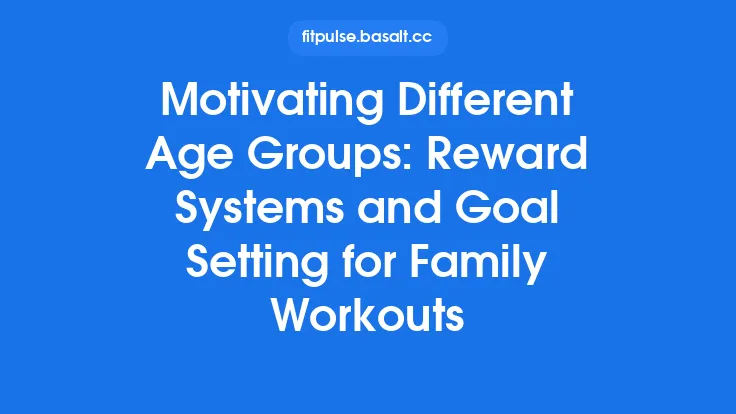Cardiovascular exercise can feel like a moving target—what drives a teenager to lace up their sneakers is often very different from what keeps a 70‑year‑old stepping out for a brisk walk. Understanding those differences and translating them into realistic, personally meaningful goals is the key to turning cardio from a fleeting chore into a lifelong habit. Below, we explore the psychological underpinnings of motivation, the unique challenges each life stage presents, and practical strategies for setting and achieving cardio‑related goals that stick.
Understanding the Motivational Landscape Across the Lifespan
Motivation is rarely a single, static force; it is a dynamic interplay of internal drives, external cues, and contextual factors. Several well‑established theories help explain why people start, maintain, or abandon cardio activities:
| Theory | Core Idea | Relevance to Cardio |
|---|---|---|
| Self‑Determination Theory (SDT) | People thrive when three basic psychological needs are met: autonomy (choice), competence (effectiveness), and relatedness (connection). | Designing cardio experiences that feel self‑directed, skill‑building, and socially supportive fuels intrinsic motivation. |
| Expectancy‑Value Theory | Motivation equals the product of expectancy (belief you can succeed) and value (importance of the outcome). | Raising confidence in cardio ability while highlighting personally valued outcomes (e.g., stress relief, social fun) boosts engagement. |
| Goal‑Setting Theory | Specific, challenging goals improve performance when accompanied by feedback and commitment. | Translating vague wishes (“I want to be healthier”) into concrete cardio targets (“Walk 30 min, 4 × week”) creates actionable pathways. |
| Habit Loop Model | Behaviors are driven by cues, routines, and rewards. | Identifying reliable cues (e.g., morning coffee) and rewarding the cardio routine (e.g., a favorite podcast) helps embed cardio into daily life. |
Across youth, adulthood, and senior years, the balance among these components shifts. Younger individuals often crave relatedness and novelty, adults prioritize autonomy and competence amid competing responsibilities, while seniors value safety, competence, and meaningful social interaction. Tailoring motivational strategies to these shifting priorities is the first step toward effective goal‑setting.
Youth: Cultivating a Positive Relationship with Cardio
1. What Drives Young People?
- Social Belonging: Peer approval and group identity are powerful motivators.
- Playful Exploration: Fun, variety, and gamified experiences keep cardio exciting.
- Immediate Feedback: Visible progress (e.g., distance tracked on a smartwatch) reinforces effort.
2. Goal‑Setting Tips for Youth
- Use “Micro‑Goals”: Break larger aspirations (“Run a 5 K”) into bite‑sized steps (“Jog 5 min without stopping”).
- Incorporate Choice: Let the teen pick the activity (dance, bike, skate) to satisfy autonomy.
- Leverage Social Platforms: Encourage participation in school clubs, family challenges, or online leaderboards that provide relatedness and friendly competition.
3. Maintaining Motivation
- Gamify the Experience: Point systems, badges, or narrative quests turn cardio into a game rather than a chore.
- Celebrate Milestones Publicly: A simple shout‑out at a family dinner or a post on a school bulletin board validates effort and reinforces relatedness.
- Teach Self‑Efficacy: Provide early successes—short, achievable intervals—so expectancy remains high.
Adult: Aligning Cardio Goals with Life Demands
1. Core Motivators for Adults
- Health Preservation: Preventing disease, managing weight, and maintaining energy levels.
- Performance & Productivity: Enhancing mental clarity, stress resilience, and work performance.
- Work‑Life Integration: Finding cardio that fits into a busy schedule without feeling like an extra burden.
2. Goal‑Setting Strategies for Adults
- Adopt the SMART Framework:
- Specific: “Cycle to work on Tuesdays and Thursdays.”
- Measurable: “Track 10 km per week.”
- Achievable: Align distance with current fitness level.
- Relevant: Connect to a larger health objective (e.g., lower blood pressure).
- Time‑Bound: “Maintain for the next 12 weeks, then reassess.”
- Stack Cardio with Existing Routines: Pair a brisk walk with a podcast you love, or do a quick HIIT session while waiting for the kettle to boil.
- Leverage Accountability Partners: A coworker, spouse, or virtual community can provide regular check‑ins, boosting both autonomy (you choose the partner) and relatedness.
3. Overcoming Common Adult Barriers
- Time Scarcity: Use “micro‑sessions” (5‑10 min bursts) that add up throughout the day.
- Perceived Lack of Progress: Schedule monthly “reflection weeks” where you review data (distance, heart‑rate trends) to see hidden gains.
- Motivation Slumps: Rotate cardio modalities (running, rowing, dance) to keep novelty alive and prevent monotony.
Senior: Embracing Cardio for Longevity and Well‑Being
1. Motivational Priorities in Later Life
- Functional Independence: Maintaining the ability to perform daily tasks safely.
- Social Connection: Group walks, community classes, or family outings provide relatedness.
- Quality of Life: Reducing joint stiffness, improving mood, and enhancing sleep.
2. Goal‑Setting Tailored to Seniors
- Focus on Functional Benchmarks: “Walk 15 minutes without stopping,” or “Climb a flight of stairs comfortably.”
- Use “Progressive Confidence” Goals: Start with low‑impact activities (e.g., seated marching) and gradually increase duration as confidence builds.
- Integrate “Purpose‑Driven” Motives: Link cardio to meaningful activities—being able to garden, attend grandchildren’s events, or travel.
3. Sustaining Motivation
- Create Social Rituals: Weekly “park walk” with a friend or a community “senior stroll” group.
- Celebrate Health Wins: Regular health check‑ups that show improved blood pressure or cholesterol can serve as powerful extrinsic rewards, reinforcing intrinsic desire to stay active.
- Simplify Feedback: Use easy‑to‑read step counters or simple heart‑rate monitors that provide clear, non‑technical cues.
Goal‑Setting Frameworks Tailored to Each Stage
| Life Stage | Primary Framework | Example Goal | Key Success Factor |
|---|---|---|---|
| Youth | Micro‑Goal + Choice Matrix | “Complete three 10‑minute dance videos this week.” | Autonomy (choice of video) + Immediate feedback (completion badge) |
| Adult | SMART + Habit Stacking | “Walk 30 minutes during lunch on Mon‑Fri for 8 weeks.” | Integration with existing schedule + Measurable outcome |
| Senior | Functional Milestone + Confidence Ladder | “Walk 20 minutes around the neighborhood without rest, three times a week, for 6 weeks.” | Gradual increase in competence + Social support (walk with a buddy) |
Each framework respects the dominant motivational drivers of its target group while still adhering to evidence‑based goal‑setting principles.
Tools and Resources to Sustain Motivation
- Digital Trackers: Simple step counters or phone‑based activity logs provide visual cues without overwhelming data.
- Goal‑Setting Apps: Platforms that let you set SMART goals, receive reminders, and log progress (e.g., Habitica, Strides).
- Community Platforms: Local recreation centers, senior centers, or school clubs that host regular cardio meet‑ups.
- Behavioral Coaching: Brief, periodic sessions with a health coach or trainer can reinforce competence and adjust goals as needed.
- Journaling Prompts: “What did I enjoy most about today’s cardio?” or “What barrier did I overcome?” help internalize progress and maintain self‑reflection.
Common Psychological Barriers and How to Overcome Them
| Barrier | Typical Manifestation | Counter‑Strategy |
|---|---|---|
| Fear of Failure | Skipping cardio because “I’m not fast enough.” | Set process goals (e.g., “Complete 5 min of continuous movement”) rather than outcome goals. |
| Boredom | Losing interest after a few weeks. | Rotate activities, introduce music playlists, or embed storytelling (e.g., “Imagine you’re exploring a new city”). |
| Perceived Lack of Time | “I can’t fit cardio into my day.” | Use micro‑sessions, combine cardio with other tasks (e.g., walking meetings). |
| Negative Self‑Talk | “I’m too old to start.” | Reframe with evidence‑based statements (“Research shows seniors who walk regularly improve balance”). |
| Social Isolation | Working out alone feels unmotivating. | Join group classes, virtual challenges, or schedule cardio dates with friends/family. |
Addressing these mental roadblocks early prevents the erosion of motivation and keeps the goal‑setting process on track.
Creating a Personal Motivation Blueprint
- Identify Core Values – Write down the top three reasons cardio matters to you (e.g., “I want to have energy for my kids,” “I aim to lower my cholesterol,” “I enjoy exploring nature”).
- Select a Primary Goal – Translate one value into a concrete, time‑bound objective using the appropriate framework for your life stage.
- Map the Habit Loop – Choose a cue (morning coffee), define the routine (10‑minute walk), and decide on a reward (listen to a favorite podcast).
- Choose Support Systems – Decide who or what will hold you accountable (friend, app, community group).
- Schedule Review Points – Set weekly or monthly check‑ins to assess progress, adjust goals, and celebrate wins.
- Iterate – Use feedback from each review to refine cues, routines, or rewards, ensuring the loop stays fresh and effective.
By following this blueprint, cardio becomes less a series of isolated workouts and more an integrated, purpose‑driven component of daily life—one that evolves gracefully as you move through youth, adulthood, and senior years.
Bottom line: Motivation and goal‑setting are the twin engines that power sustainable cardio across the lifespan. By recognizing the shifting psychological needs of each age group, employing stage‑appropriate goal frameworks, and building robust habit loops supported by technology and community, anyone can craft a cardio journey that feels both meaningful and achievable—no matter where they are in life.





